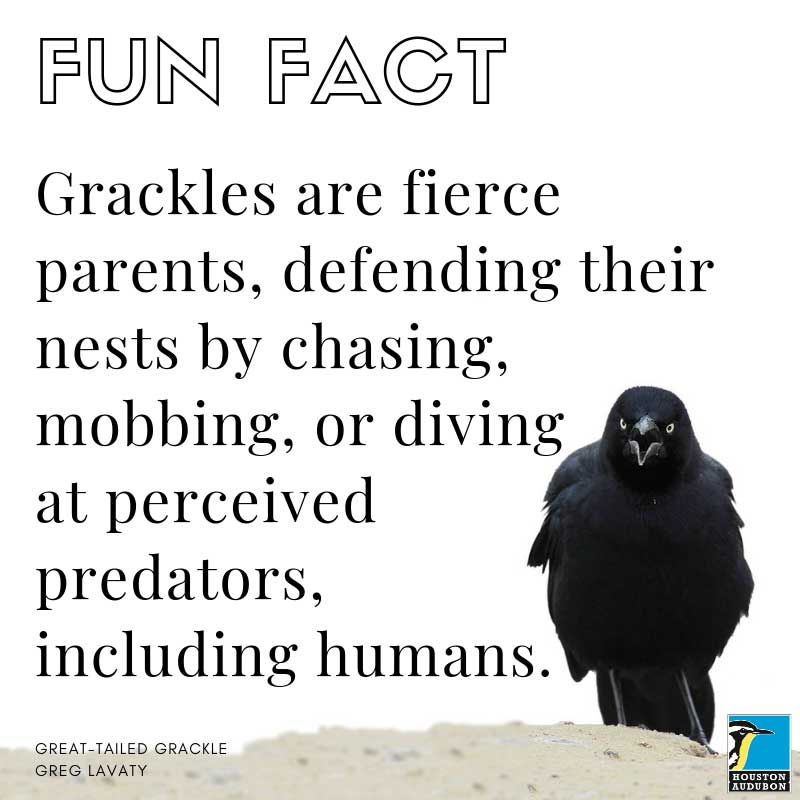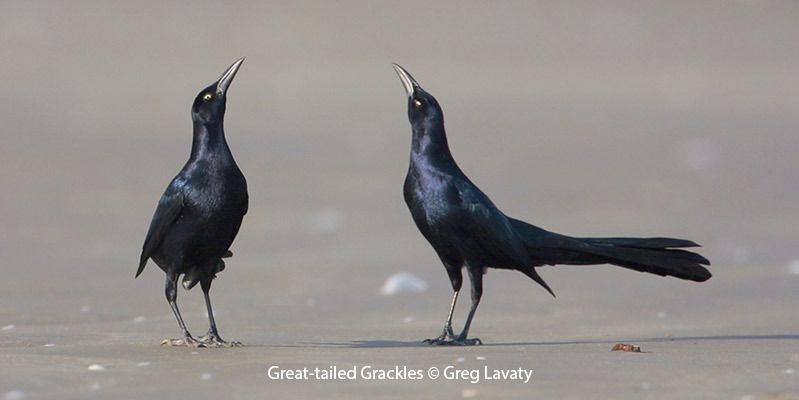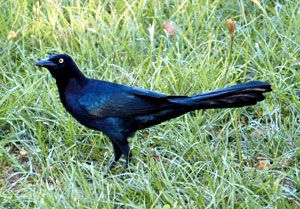
© Mary Anne Weber
Great-tailed Grackle
Quiscalus mexicanus
Family: (Icteridae) Blackbirds, Orioles, and Allies
Preferred Habitat: Urban and rural areas.
Seasonal Occurrence: Permanent resident. Abundant throughout the year.
Profile by Vicki Stittleburg: The Great-tailed Grackle is North America's largest grackle. Males have an all black body with bluish purple iridescence, a long, tapered tail that folds into a distinctive keel shape, yellow eyes, long black legs and a black stout bill. Females are about half the size of males; they have a grayish brown body, a buff-colored throat, yellow eyes, a lighter eyebrow and a shorter tail. Juveniles have the female’s dark brown plumage, with streaked underparts and a dark eye.
In 1900, the northern edge of the Great-tailed Grackle’s range barely reached southern Texas. Since the 1960s they’ve followed the spread of irrigated agriculture and urban development into the Great Plains and West, and today are one of North America’s fastest-expanding species. Great-tailed Grackles are a permanent sight in Houston and can be found in any area inhabited by humans that has some trees. They tend to congregate in large flocks and prefer shopping centers and fast-food store parking lots where there's trash for food and trees or light posts for perching.
Great-tailed Grackles have a wide repertory of songs and sounds including piercing whistles and creaks. In the evening, raucous flocks pack neighborhood trees creating noisy roosting aggregations.
Profile by Rachel Myers: The Great-tailed Grackle is North America’s largest grackle and a common permanent resident throughout Texas. They can be found just about anywhere in their range and birders and non-birders alike have observed flocks of these loud and social birds. Great-tailed Grackles are long-legged, slender blackbirds with long V-shaped tails. They have rather flat heads and a stout bill. Male Great-tailed Grackles are black with yellow eyes, with iridescent feathers that flash beautiful blues and purples. Females are dark brown above and paler brown below. Their plumage color stays the same throughout the year.
Great-tailed Grackles look most similar to Common Grackles as well as Boat-tailed Grackles. Common Grackles are significantly smaller than Great-tailed and Boat-tailed Grackles and have shorter, flatter tails. Great-tailed Grackles and Boat-tailed Grackles are more similar in size but can be distinguished from each other by eye color. Great-tailed Grackles have pale yellow eyes, where Boat-tailed Grackles have dark eyes.
Great-tailed Grackles can be found in both agricultural and urban settings. As long as they have open foraging areas, a water source, and trees or hedgerows, Great-tailed Grackles thrive just about anywhere. They can be found on fields, farmyards, parks, neighborhood lawns, and dumps to name a few places. Natural habitat preference includes chaparral and second-growth forests. Great-tailed Grackles eat plant material year-round, including grains such as corn, oats, and fruits. In the summer, they will start to feed on animals including insects such as grasshoppers, beetles, and spiders. They will also feed on frogs, lizards, snakes, fish, small mammals, and even other bird eggs and nestlings.
When preparing for nesting, females choose the nest site, picking a high place in a tree or shrub with water and foraging areas nearby. When trees aren’t available, females choose sites in marsh vegetation, or even human-made structures such as telephone poles. She may abandon her initial nesting site however, in favor of a new site or new mate.
Great-tailed Grackles are loud and social birds that can form flocks of up to tens of thousands of birds. Small groups will disperse in the morning to feed and then return to roosting sites at dusk. This evening gathering includes a constant cacophony of squeals, whistling, and rattling as birds choose their favorite spot for the night. In early spring, males establish breeding territories and defend them aggressively against other males. Males often perform territorial displays, where they raise their feathers, fan their tails, and raise their bills skyward. Males often mate with one or more “social mates” within their territory and may try to mate with other females. Females have a single social mate but may copulate with other males.
In 1900, the northern edge of the Great-tailed Grackle’s range barely reached southern Texas. Today, due to the spread of agriculture and urban development, Great-tailed Grackles are largely present year-round throughout their range which extends from all of Texas, the Southwest, and southern Great Plains. Their range also extends into Central America and northern South America. On the Upper Texas Coast, Great-tailed Grackles are abundant throughout the year and can be seen just about anywhere, including throughout High Island, foraging on fields and lawns.
-
Cornell Lab of Ornithology
-
Bird Guide
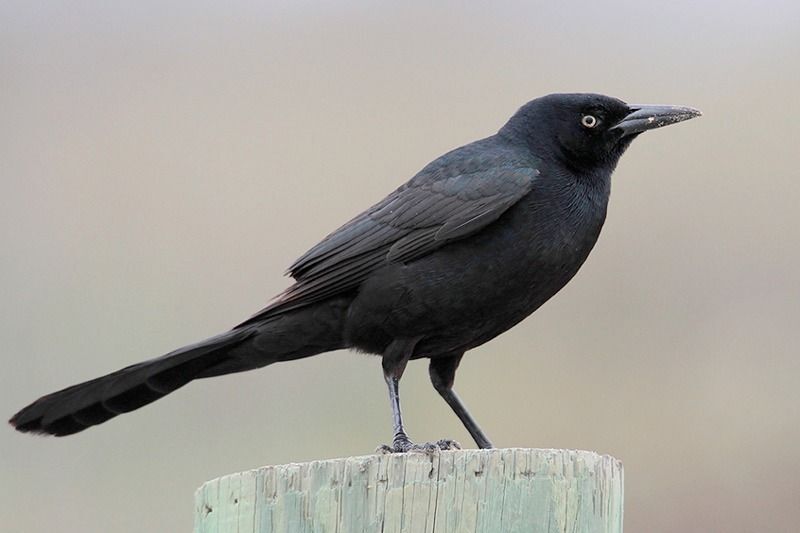
© Greg Lavaty, www.texastargetbirds.com
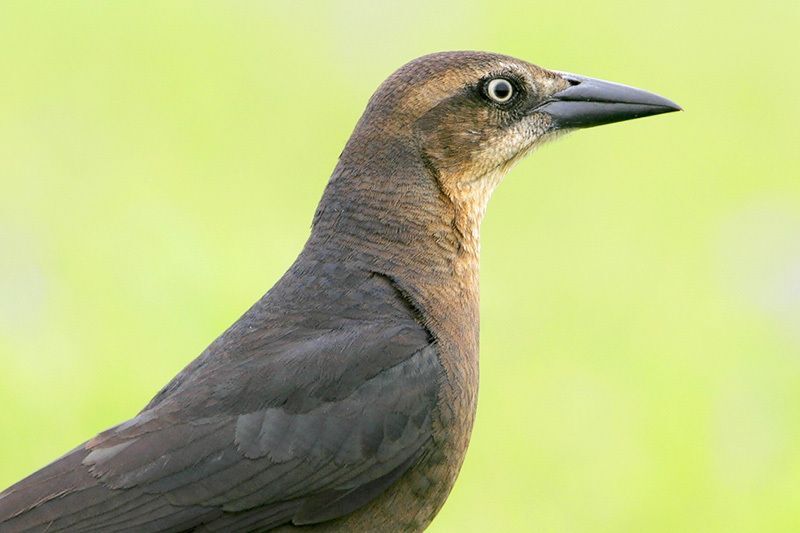
© Greg Lavaty, www.texastargetbirds.com
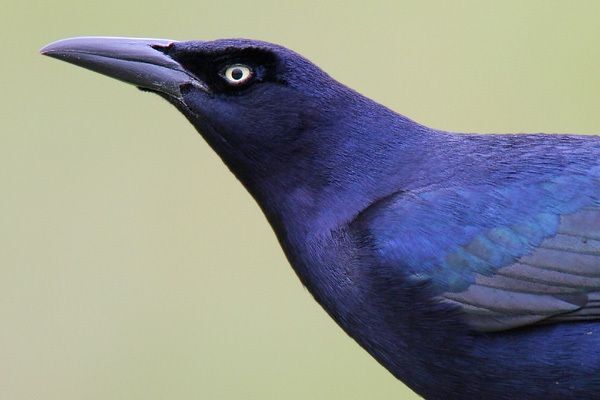
© Greg Lavaty, www.texastargetbirds.com
